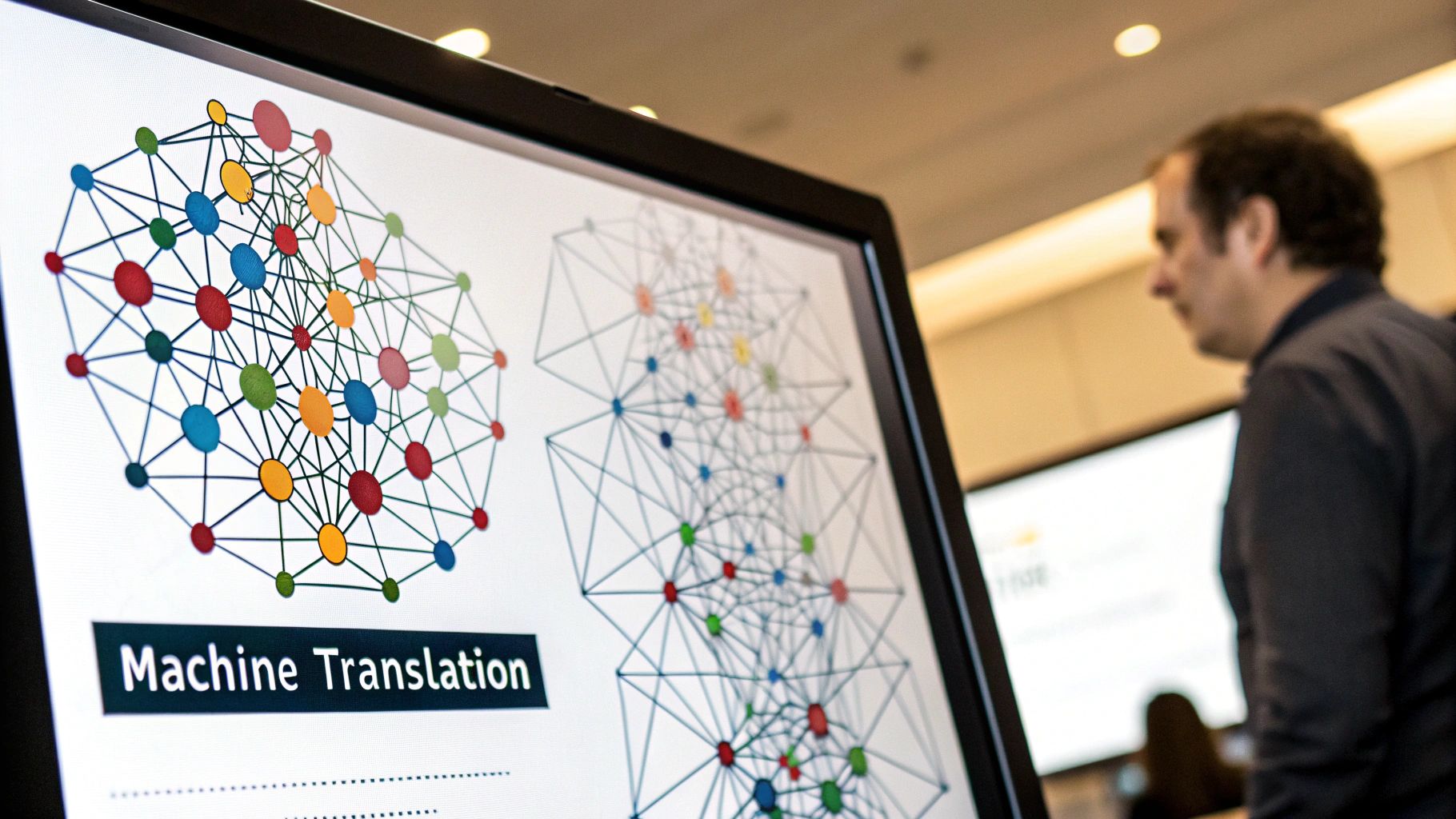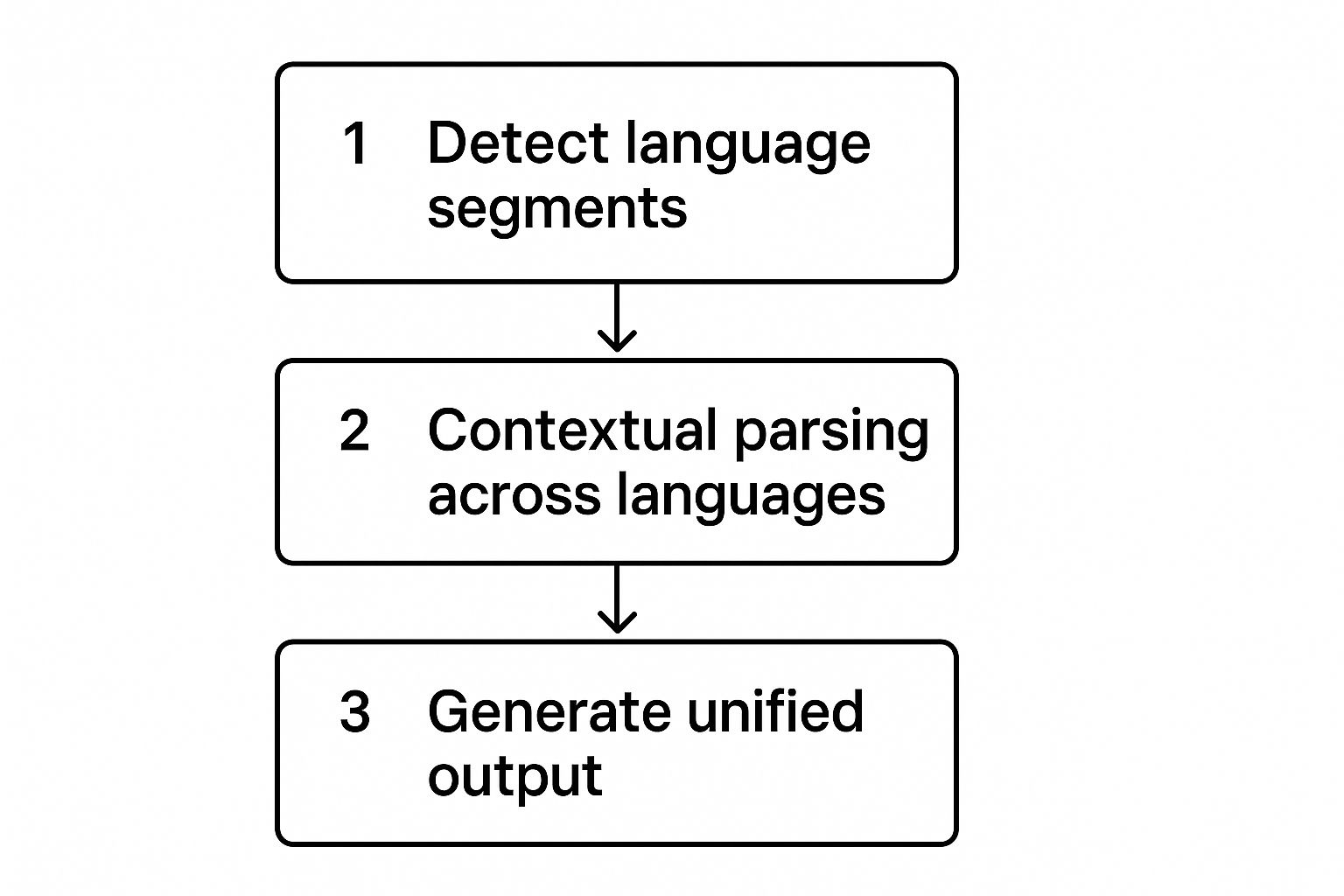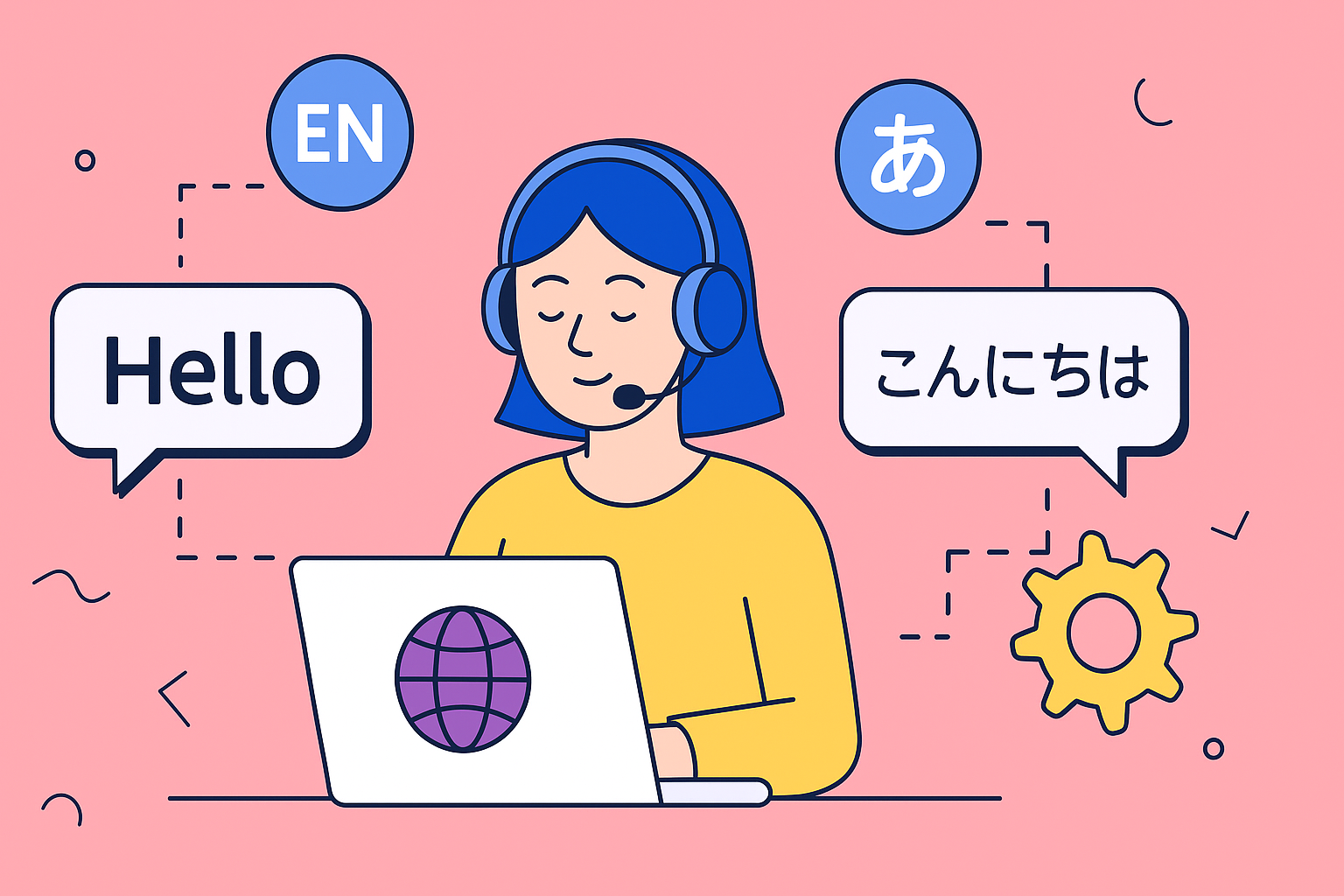Picture this: a support ticket lands in your queue. It’s written in a language nobody on your team speaks, and you can tell from the tone that the customer is already at their wit’s end.
This single interaction grinds everything to a halt. It creates friction, slows down your team, and puts you at risk of losing a customer for good. For any business with a global footprint, this isn’t a hypothetical—it’s a daily reality.
Why Single-Language Support Is No Longer Enough
In today’s connected world, running a single-language support desk is like building a bridge that only goes halfway across a river. Sure, you’ll connect with some people, but you’re leaving a huge chunk of your audience stranded on the other side.
This is why having a multi language strategy isn’t just a “nice-to-have” feature anymore; it’s a core business requirement. It’s all about making sure every single customer, no matter what language they speak, feels seen, heard, and understood.
This isn’t just about being polite. It’s about survival and growth. When customers can get help in their own language, their satisfaction goes through the roof. But force them to struggle through a second language or fumble with a clunky external translator, and you’ve introduced immediate frustration.
The Reality of a Global Audience
While English is definitely a major player in global business, banking on it being enough is a rookie mistake. It’s true that English is the most spoken language, with around 1.5 billion speakers. But here’s the kicker: only 25% of those are native speakers. The rest learned it as a second, third, or even fourth language.
That massive gap tells you everything you need to know. The real key to clear communication and building a genuine connection is meeting customers in their native language.
For a service desk, the goal isn’t just to translate words. It’s to convey understanding and empathy. True multi language support makes the entire conversation feel native, breaking down the barrier so agents can focus on solving problems, not just deciphering them.
Bridging the Communication Gap
Without a solid system in place, service desks often fall back on clunky workarounds that just create more headaches. You’ve probably seen these challenges firsthand:
- Slow Resolution Times: Agents burn precious minutes copying and pasting text into separate translation tools, which means customers are left waiting.
- Costly Misunderstandings: A bad translation can lead to the wrong solution, sparking repeat tickets and damaging the customer relationship beyond repair.
- Limited Scalability: Hiring native speakers for every possible language is incredibly expensive and, frankly, impractical for most growing companies.
Ultimately, effective multi language support is about more than just swapping words. It requires true language localization to make sure your communication resonates in different cultural contexts. By bringing modern AI solutions into the mix, you can build a seamless experience that feels personal and efficient, turning language from a barrier into your biggest competitive advantage.
What Does a Seamless Multi-Language Experience Actually Look Like?

Real multi-language support isn’t about clunky, word-for-word translation. It’s more like having a universal translator working silently inside your service desk. This invisible, intelligent layer makes sure communication just flows between customers and agents, no matter what language they speak.
The aim is to create an experience so smooth that language barriers just disappear. A customer in Japan can log a ticket, browse help articles, and get updates—all in Japanese. At the same time, your support agent in Dublin can read, manage, and reply to that exact same ticket, seeing everything in English.
For both people, the entire process should feel completely natural. The customer isn’t forced to use a language they don’t know, and the agent doesn’t have to break their workflow by jumping out to a separate translation tool.
The Anatomy of a Frictionless Experience
A truly seamless multi-language system relies on a few core pieces working together in the background. They’re all designed to automate communication and present information in the user’s native language at every single touchpoint.
Here’s what that looks like:
- Automated Ticket Translation: The moment a customer submits a request, its summary, description, and every comment that follows are instantly translated into the agent’s primary language.
- Localized Customer Portals: The entire customer-facing portal—from request forms to navigation buttons—appears in the user’s preferred language, making the experience intuitive and familiar.
- Translated Knowledge Base: Self-service articles and FAQs are translated on the fly, allowing customers to solve their own problems without even needing to create a ticket.
This level of integration makes the support journey feel native from end to end. If you want to dive deeper into making this a reality, see how you can achieve Multilingual Mastery with AI.
Shifting from Manual Labor to Smart Automation
The old-school way of handling a ticket in another language is a massive productivity drain. It means copying text, pasting it into Google Translate, trying to make sense of the (often flawed) output, and then doing it all in reverse to send a reply. This workflow is slow and full of opportunities for miscommunication.
A modern, integrated solution gets rid of all those manual steps. AI-driven tools operate directly within your service management platform, like Jira Service Management, handling the translations instantly.
This shift is huge. You go from a reactive, manual process where every foreign-language ticket is a problem, to a proactive, automated system where language is an afterthought. The focus snaps back to what actually matters: solving the customer’s issue, fast.
The Agent and Customer Journey in Action
Let’s walk through a real-world example. Imagine a customer in Brazil is having trouble with a piece of software.
- Customer Action: She lands on your support portal, which automatically shows up in Portuguese. She writes a detailed ticket explaining her issue in her native language and hits submit.
- Instant Translation: The ticket appears in your agent’s queue in England. Before the agent even clicks on it, the entire request—title, description, and all—has been translated into perfect English.
- Agent Response: The agent figures out the solution and writes a clear, step-by-step reply in English. When he sends it, the response is instantly translated back into Portuguese for the customer.
Neither person had to even think about translation. The customer got fast, clear help in her own language, and the agent resolved the ticket efficiently without ever leaving his JSM screen. That’s the power of a truly integrated multi-language system.
Unlocking Growth with a Multi Language Strategy

Thinking about multi language support as just another IT upgrade is missing the bigger picture. It’s a fundamental business strategy, one that drives real, measurable growth by directly improving the experience for the people who matter most: your customers.
When customers can ask for help in their native language, everything changes. The interaction becomes easier, quicker, and far more personal. That’s the golden formula for boosting customer satisfaction (CSAT) scores.
This isn’t just a hunch; the data backs it up. Research shows that 74% of consumers are more likely to buy from a brand again if they receive after-sales care in their own language. That kind of loyalty is what builds higher customer lifetime value and turns users into advocates.
Elevate Customer Satisfaction and Loyalty
Picture this: a customer in Madrid has a tricky technical question. They submit a ticket and get a clear, helpful response in perfect Spanish almost immediately. Now, contrast that with the all-too-common experience of struggling through a clunky, auto-translated response that barely makes sense. The first scenario builds trust; the second creates friction.
A seamless multi language experience cuts out that friction entirely. It sends a clear message to your global customers: we value you enough to speak your language. This simple act of respect can be the very thing that keeps them coming back.
Boost Agent Efficiency and Morale
Your support agents are the heart of your service desk, and their productivity directly impacts your bottom line. When they’re stuck manually copying and pasting text into external translation tools, they aren’t solving problems—they’re just translating.
Automating translation right inside their workflow gives them that time back. The benefits are immediate and tangible:
- Faster Resolutions: With instant translation, agents can understand, troubleshoot, and resolve a ticket up to 50% faster. This slashes operational costs and dramatically improves key metrics like average handling time.
- Reduced Agent Burnout: Let’s be honest, manual translation is a soul-crushing task. Removing it from their plate improves job satisfaction and morale. Happier, less-stressed agents deliver better service.
- Unified Queues: Forget juggling separate queues for different languages. All tickets can flow into a single, unified system, simplifying management and ensuring tickets are handled by priority, not language.
When you equip your team with the right tools, you empower them to do what they do best. To see how this works in the real world, check out these five key use cases for a multilingual service desk that can instantly upgrade your team’s performance.
Implementing an integrated multi language solution is an investment in your team’s capacity. It transforms agents from translators into expert problem-solvers, allowing them to handle more tickets with greater accuracy and less stress.
Let’s break down the real-world effects of adopting multi language support. The table below shows a clear before-and-after picture, connecting language capabilities directly to the metrics that business leaders care about.
Impact of Language Support on Key Business Metrics
| Business Metric | Impact Without Multi Language Support | Impact With Multi Language Support |
|---|---|---|
| Customer Satisfaction (CSAT) | Lower scores due to communication friction and misunderstandings. | Higher scores driven by clear, effortless communication in the customer’s native language. |
| First Contact Resolution (FCR) | Reduced FCR as agents struggle to understand complex issues, leading to back-and-forth. | Increased FCR as agents grasp the full context of the issue instantly, enabling quicker solutions. |
| Average Handling Time (AHT) | Inflated AHT from time spent on manual translation and clarifying customer requests. | Drastically reduced AHT as translation becomes instantaneous within the workflow. |
| Agent Productivity | Low productivity; agents spend significant time on non-value-added translation tasks. | High productivity; agents focus solely on problem-solving, handling a larger volume of tickets. |
| Customer Churn | Higher churn rates as frustrated customers seek support from competitors who speak their language. | Lower churn and increased loyalty; customers feel valued and understood, strengthening the brand relationship. |
| Market Expansion | Limited global reach; unable to effectively support customers in new, non-native language markets. | Unlocked global growth; ability to enter new markets and provide full support with minimal overhead. |
As you can see, the impact isn’t just on the support team—it ripples across the entire business, from customer loyalty to revenue growth. This isn’t just about being nice to have; it’s a strategic imperative for global competition.
Unlock New Global Market Opportunities
Maybe the most powerful argument for a multi language strategy is its ability to pry open the doors to new international markets. Many companies hold back on global expansion precisely because they can’t provide effective local-language support.
Imagine a software company noticing a surge of trial sign-ups from Brazil, but they have no Portuguese-speaking agents. By plugging in an AI translation tool, they can start offering high-quality support in Portuguese overnight. That initial trickle of interest can quickly become a steady stream of paying customers, opening up an entirely new revenue channel with almost no extra hiring.
The world is a diverse place. Around 43% of people worldwide—that’s roughly 3.3 billion individuals—are bilingual. Another 17% can communicate in three or more languages. This represents a massive, interconnected customer base that expects companies to meet them where they are. Offering support in local languages isn’t a bonus feature for global expansion anymore; it’s the price of entry.
The Hidden Costs of Language Barriers in Support

Running a support desk without the right multi language tools feels a bit like trying to run an emergency hotline where the operator and caller can’t understand each other. The intention to help is there, but the entire process grinds to a halt, bogged down by confusion, delays, and a real risk of making a bad situation worse.
This isn’t just a minor headache. It’s a constant, silent drain on your team’s resources, morale, and customer relationships.
The most glaring cost is time. Every single ticket that lands in the queue in a foreign language kicks off a clunky, manual workflow. An agent has to stop what they’re doing, copy the text, jump over to an external translation tool, paste it in, and then do the whole thing again for their reply.
Those little copy-paste actions don’t seem like much, but they stack up fast. We’re talking hours of lost productivity every single week.
And it’s not just about speed. This manual process actively hurts the quality of your support. Public translation tools are notoriously bad with context, industry-specific jargon, and cultural nuances. One poorly translated word can send an agent down a completely wrong troubleshooting path, leading to incorrect fixes and incredibly frustrated customers.
The Escalating Price of Misunderstanding
When communication breaks down, the consequences ripple outward, creating problems that are far more expensive than just lost time. A simple request can quickly spiral into a major issue, all because of a language gap.
These hidden costs show up in several painful ways:
- Cripplingly Slow Response Times: Every minute spent toggling between browser tabs for manual translation adds to your First Response Time (FRT), a critical metric for customer happiness. While your agent is playing copy-paste, your customer is just… waiting.
- Critical Misunderstandings: A mistranslated technical term isn’t just awkward; it’s dangerous. It can lead to the wrong solution being offered, which means more tickets, more work, and a serious blow to customer trust.
- Skyrocketing Agent Frustration: Constantly fighting with language barriers is mentally exhausting for your support staff. It dramatically increases their cognitive load and is a fast track to burnout, which poisons the whole team’s performance.
To get ahead of these costs, you need effective communication strategies that can bridge these divides. But when the root of the problem is the language itself, the best strategy is a tool designed to tear that barrier down completely.
The Flawed Logic of Hiring for Every Language
A common gut reaction to these challenges is to just hire more multilingual agents. And while having native speakers is a huge asset, trying to scale this approach for a global customer base is often a financial and logistical nightmare.
Think about it: finding qualified agents who are fluent in specific languages and have the technical skills you need is incredibly difficult. You might spend months finding a fantastic German-speaking agent, only for your next big wave of tickets to come from Japan.
This strategy is always one step behind. It’s expensive, reactive, and simply doesn’t scale as you grow. It’s like trying to build a new bridge every time a car needs to cross a river, instead of just getting a ferry that can go wherever it’s needed.
Relying on manual workarounds is a hidden tax on your support operations. You pay for it in wasted agent hours, frustrated customers, and missed growth opportunities. The longer you wait to address the root problem, the higher the cost becomes.
Ultimately, the friction caused by language barriers puts a constant drag on your team’s efficiency and your customers’ experience. While tools like Google Translate might seem like a quick fix, their limitations in a professional support environment become obvious fast. For a deeper dive, you can check out the pros and cons of using Google Translate for Jira and JSM.
The real path forward is a solution that’s integrated, intelligent, and built for the real-world demands of a modern service desk.
How AI Delivers Effortless Live Translation
Forget those clumsy, word-for-word online translators from a decade ago. Modern AI translation acts more like an invisible, real-time interpreter built right into your service desk. It creates such a fluid conversation that language differences just melt into the background.
This is all thanks to sophisticated AI models that go beyond simple words to understand context, nuance, and even a customer’s intent. When a ticket comes in, the technology doesn’t just swap German words for English ones; it grasps the meaning behind the request. The result is a workflow that feels almost magical for everyone involved.
The Customer and Agent Journey Visualized
Let’s walk through a scenario to see this in action. Imagine Klaus, a customer in Germany, is having trouble with a recent purchase. Over in a support center in Ireland, an agent named Sarah is ready to help.
- Ticket Submission in German: Klaus heads to the customer portal, which is already in German for him. He types out his problem, complete with local slang and maybe a technical term or two, and hits submit.
- Instantaneous AI Translation: The second Klaus submits the ticket, it pops into Sarah’s Jira Service Management queue. Before she even clicks on it, an integrated app like Issue Translation for JSM has translated the entire request into perfect English.
- Agent Response in English: Sarah reads the ticket, gets the full picture, and writes a clear, step-by-step reply in her native English.
- Seamless Delivery in German: When Sarah posts her comment, the AI instantly flips it back into natural-sounding German. Klaus gets an email notification and sees a helpful response in his own language, as if it came from a local expert.
From Klaus’s perspective, he got fast, professional support in German. From Sarah’s side, she handled another ticket efficiently in English. Neither one had to even think about translation—it just worked.
The screenshot below gives you a peek into the agent’s view in Jira Service Management. You can see the original and translated text side-by-side, giving the agent complete clarity.

This bilingual view is a game-changer. It gives agents the full context they need to resolve issues accurately without ever breaking their stride.
Creating a Single Unified Support Queue
This on-the-fly translation completely transforms how support teams are structured. You can stop creating separate, siloed queues for different languages—a practice that’s both inefficient and a headache to manage. Instead, all tickets flow into one unified queue.
This simple shift means tickets get handled based on agent availability and priority, not language skills. An English-speaking agent can tackle a ticket from Japan just as easily as one from down the street. It levels the playing field for your team and gets rid of frustrating bottlenecks. To learn more about how this improves operations, check out the advantages of computer-assisted translation.
With integrated AI, you don’t need a multi language team—you need a great team with a multi language tool. This shift allows you to hire the best talent, regardless of the languages they speak, and still provide world-class global support.
A unified system is particularly powerful when you’re serving markets where the language has a massive speaker base but a smaller presence online. For example, Mandarin Chinese has over 1.1 billion speakers worldwide, making it the second most spoken language, yet it makes up only 1.3% of all internet content. AI translation closes this gap, letting you connect with huge, underserved markets.
The Technology Behind the Magic
So, what’s powering this “magic”? The secret is advanced neural machine translation (NMT). These AI models are trained on billions of text examples from countless languages, which allows them to learn the patterns, grammar, and cultural nuances that make communication sound genuinely human.
Unlike older methods that spat out robotic, literal translations, NMT models look at the entire sentence to figure out the context. This technology is always getting smarter, too, constantly learning from new data to make its translations even more accurate and natural. A related field that relies on similar complex language models is voice to text AI technology, which offers a deeper look at the underlying mechanics.
By building this power directly into platforms like Jira Service Management, you can offer a top-tier multi language customer experience without the enormous cost of hiring specialized staff. It’s a smart, scalable, and affordable way to take your support global.
Your Next Steps Toward Global Service Excellence
Taking your service desk global starts with a simple, honest admission: a single-language support desk just doesn’t cut it anymore. We’ve walked through the clumsy workarounds of manual translation, the very real costs of language barriers, and the elegant power of integrated AI. A multi language strategy isn’t just another IT project; it’s a direct investment in customer loyalty, global growth, and your company’s future.
So, where do you begin? It’s time to take a hard look at your own operations. Start by asking some pointed questions to uncover how language gaps are really affecting your team and your customers.
Assess Your Readiness
A quick internal audit can shine a light on your most urgent pain points—and your biggest opportunities. Use this framework to get started:
- Quantify Wasted Time: How many hours are your agents losing every week to copy-pasting into translation tools? This number alone can make a powerful case for the immediate ROI.
- Identify Market Gaps: Which emerging markets are you struggling to serve because you can’t speak their language? Pinpointing these regions gives you a clear roadmap for expansion.
- Review Customer Feedback: Dig into your CSAT scores. Are low ratings or negative reviews often tied to communication problems or sluggish response times for non-native speakers?
- Analyze Agent Burnout: Is the mental strain of deciphering different languages contributing to frustration or turnover on your team? Be honest.
This isn’t just about gathering data; it’s about building a compelling business case. What you’ll likely find is that the cost of doing nothing far outweighs the investment in an automated solution. For a deeper dive into the numbers, our automatic translation report breaks down the business impact in detail.
Moving to a multi language model is about empowering your team to deliver their absolute best, no matter where a customer is. It’s about making every single person feel heard and understood.
This need for global connection isn’t a trend; it’s just a reflection of how the world works. According to 2025 Ethnologue data, dozens of languages have over 50 million native speakers. This creates a rich, diverse ecosystem where being multilingual isn’t just nice to have—it’s essential for business. If you’re curious, you can explore the full distribution of global languages on Wikipedia and see the sheer scale of the opportunity.
Ultimately, the path forward is clear. By building intelligent translation directly into your service desk, you’re not just adding a feature. You’re dismantling the very barriers that hold your team back and opening the door to a truly global customer base. You have what you need to lead this change and build a support experience that can scale right alongside your ambitions.
Your Questions About Multi Language Support, Answered
Bringing new technology into your service desk always sparks a few questions. Let’s walk through the most common ones about adding AI-powered multi language support so you can see just how practical it is in terms of accuracy, security, and day-to-day use.
How Accurate is AI Translation for Technical Issues?
Modern AI translation has come a long way from the clunky, literal translations of the past. Today’s top-tier systems run on neural machine translation (NMT), which is smart enough to look at the entire context of a sentence. This means it can deliver surprisingly accurate results, even when dealing with complex technical language.
For example, an app like Issue Translation for JSM can actually learn your industry-specific lingo. This ensures a bug report from a developer in Germany is translated with the right technical terms for an agent in the US, heading off critical mix-ups. And while no AI is perfect, agents often have the chance to review and tweak translations before they go out, guaranteeing 100% accuracy when it matters most.
What’s the Implementation Process Really Like?
Getting started is refreshingly simple. Since solutions like Issue Translation for JSM are native apps you grab from the Atlassian Marketplace, you’re not looking at a massive, multi-department project. It’s usually just a quick install.
Once it’s in, you handle the configuration right inside Jira on a project-by-project basis. Setting default languages and picking your translation mode takes just a few clicks. The whole thing is built for a Jira admin to manage without needing a ton of IT resources.
Can AI Handle Slang and Industry Jargon?
Yes, and this is where modern AI really shines. NMT models are trained on gigantic datasets that include everything from formal documents to casual customer chats. This gives the AI the ability to correctly interpret slang, abbreviations, and conversational tones.
The real magic of a sophisticated AI is its ability to grasp intent, not just individual words. It can tell when a customer using informal language is frustrated and translate that sentiment along with the text. This gives agents the full emotional context they need to craft a genuinely helpful response.
This capability makes sure the natural, human way a customer talks doesn’t get lost in translation.
How Is Our Data Security and Privacy Protected?
This is a non-negotiable for enterprise-grade tools. All translation requests are sent over secure, encrypted connections (HTTPS). Reputable providers are upfront about their data handling policies and often have key certifications like SOC 2 or are fully GDPR-compliant.
Even better, your customer data isn’t typically stored long-term by the translation service. The text gets processed for an immediate translation and is then discarded, keeping sensitive customer information confidential. As a rule of thumb, always check the security credentials of any app before you install it.
Ready to break down language barriers and deliver truly global support? resolution Reichert Network Solutions GmbH makes it simple. Try Issue Translation for JSM free from the Atlassian Marketplace and see how easy it is to build a world-class, multi language service desk. Learn more and start your free trial today: https://www.resolution.de/issue-translation-for-jsm
